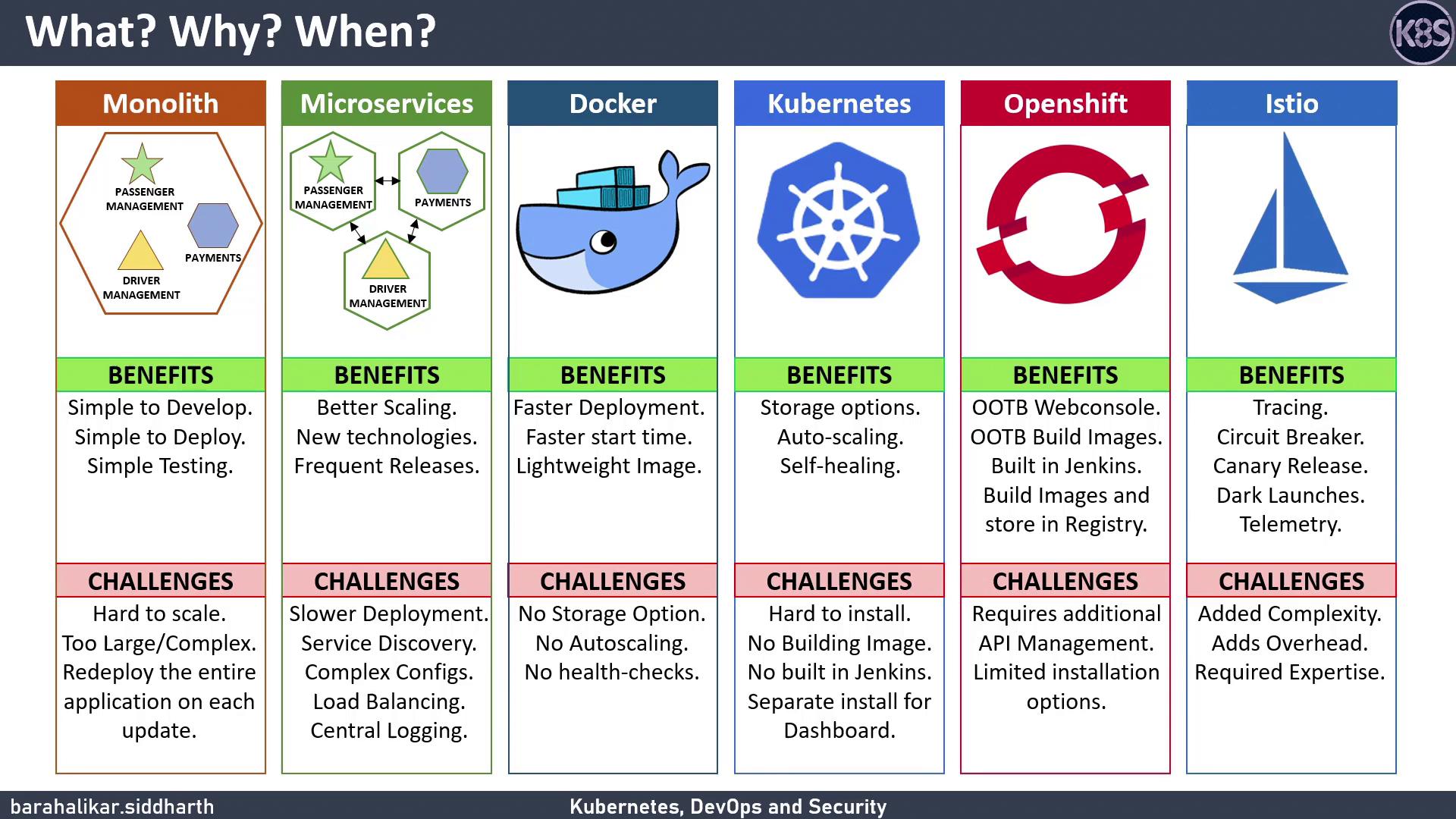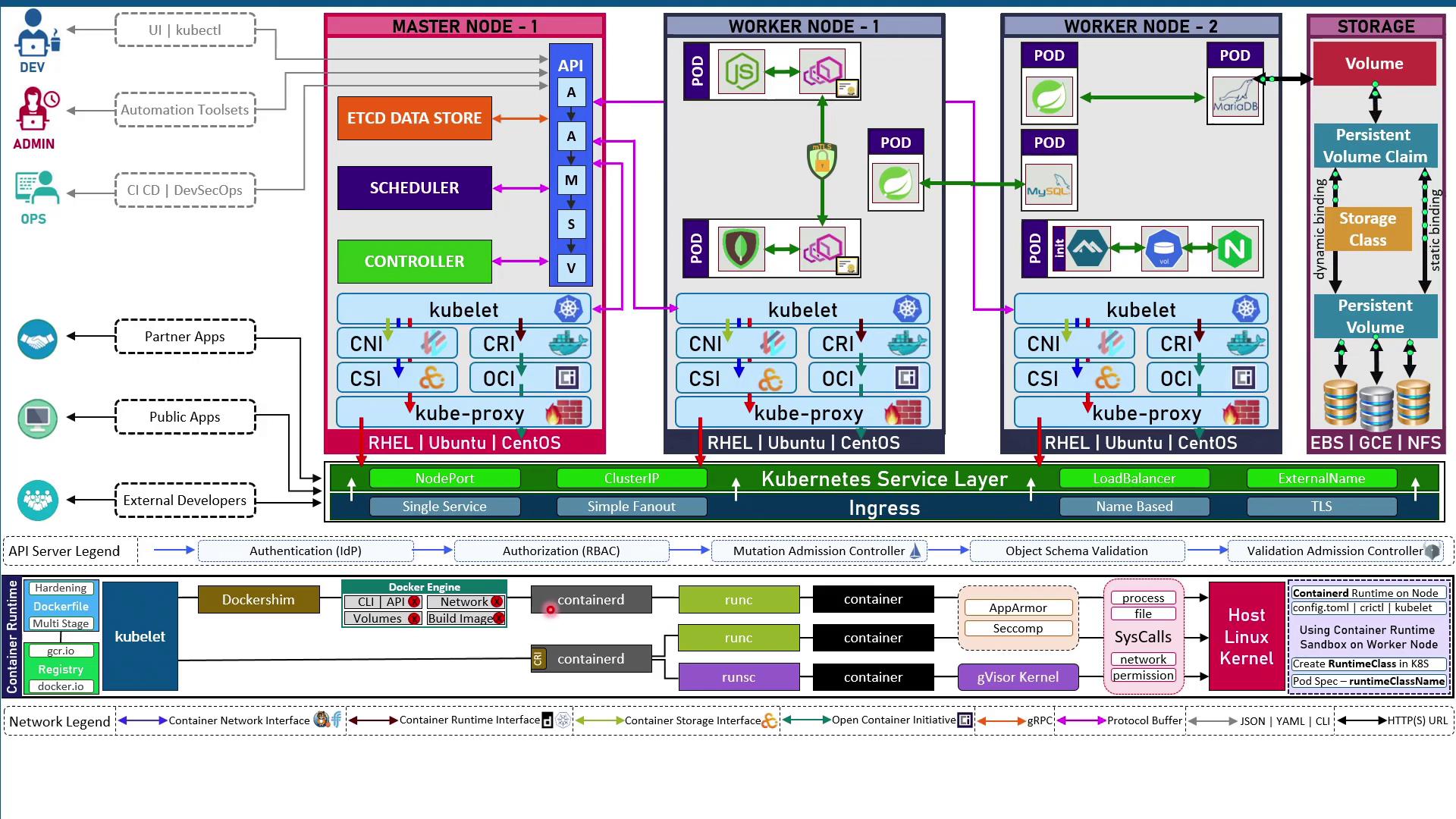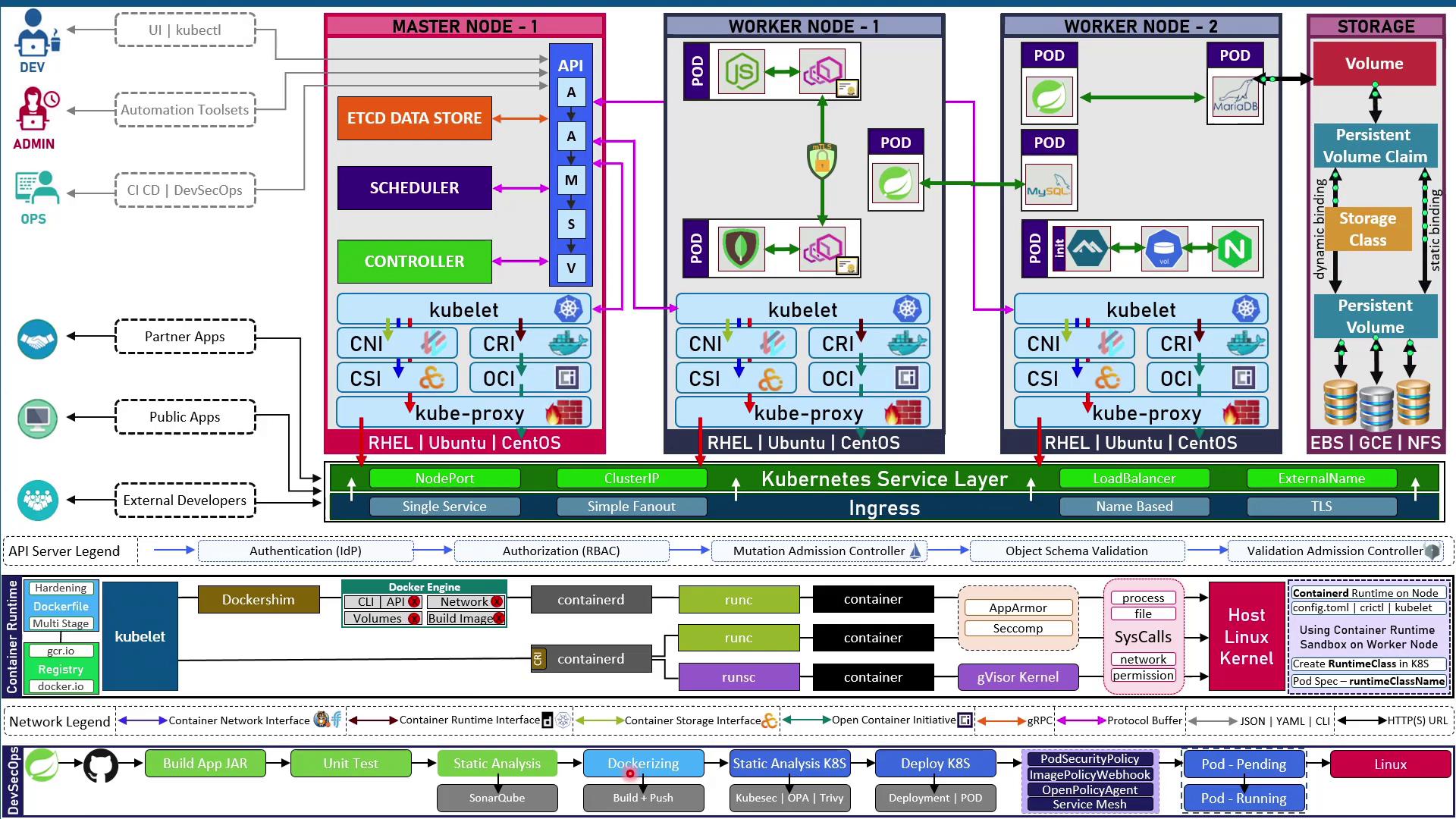DevSecOps - Kubernetes DevOps & Security
Additional Topics
Kubernetes Architecture
In this guide, we’ll examine when and where to use Kubernetes, explore its core components, and take a deep dive into its cluster and control-plane architecture.
Evolution of Application Architectures
Monolithic Applications
Early applications bundled all functionality into a single deployable unit. For example, an Uber-like app might combine passenger management, payment processing, and driver routing in one binary.
Benefits:
- Simple development and testing with one codebase
- Single configuration file and PaaS deployment
Challenges:
- Inefficient scaling: you must replicate the whole app
- Large codebase hinders team onboarding
- Every change triggers a full redeploy
Microservices
Breaking a monolith into independent services allows each to be developed, deployed, and scaled separately.
Benefits:
- Fine-grained scaling for busy services
- Faster release cycles per team
Challenges:
- Service discovery requires a central registry
- Configuration sprawl calls for a unified config store
- Distributed tracing, logging, and load balancing add complexity
Docker and Containers
Docker packages applications with their dependencies into lightweight containers.
Benefits:
- Rapid startup vs. VMs
- Smaller images including only necessary libraries
Challenges:
- No built-in auto-scaling or self-healing without orchestration
Kubernetes: Container Orchestration
Kubernetes automates deployment, scaling, and management of containerized workloads.
Benefits:
- Auto-scaling, self-healing, rolling updates out of the box
- Portable storage abstractions and rich ecosystem
Challenges:
- Initial setup can be complex (binaries, certificates)
- Requires external build pipelines; it doesn’t build container images
- Dashboard is an add-on, not built in
Platform-as-a-Service (PaaS)
Platforms like OpenShift, Rancher, and Cloud Foundry bundle runtimes, orchestration, and CI/CD.
Example: OpenShift
- Web console, integrated Jenkins pipelines, built-in registry
- Supports Docker and Podman for image builds
Considerations:
- Extra API layers add overhead
- Customization and installation can be limiting
Service Mesh
A service mesh (e.g., Istio) overlays Kubernetes to secure and observe microservices.
Benefits:
- mTLS, circuit breakers, canary deployments, tracing
- Integrations with Prometheus, Grafana, Kiali, Jaeger
Warning
Adding a service mesh increases resource usage and cluster complexity. Ensure you monitor performance and avoid misconfiguration.

Kubernetes Cluster Architecture
At the heart of Kubernetes are pods, the smallest deployable units that run one or more containers. Pods run on worker nodes (VMs or physical servers). For high availability, you deploy multiple workers so workloads shift if a node fails.
A separate control plane (master nodes) manages scheduling, state, and the API. Running multiple control-plane nodes ensures redundancy.
Control Plane Components
- etcd
A highly-available key-value store that persists all cluster state. - kube-apiserver
The central API gateway; the only component that communicates directly with etcd. - kube-scheduler
Assigns pods to nodes based on resource requirements and constraints. - kube-controller-manager
Runs controllers (e.g., ReplicaSet, Endpoint) to enforce the desired state.

kubelet and the Container Runtime
Each node (control plane and worker) runs a kubelet agent that:
- Watches the API server for PodSpecs.
- Uses the Container Runtime Interface (CRI) to pull and launch containers.
Supported runtimes include Docker, containerd, and CRI-O, all conforming to the OCI (Open Container Initiative) specs:
- Image spec: Defines how container images are built.
- Runtime spec: Defines how containers are unpacked and executed.

Networking with CNI and kube-proxy
- CNI (Container Network Interface)
Plugins like Calico, Flannel, and Weave Net assign each pod a unique IP. - kube-proxy
Programs iptables or IPVS rules to enable pod-to-pod networking and expose services externally.
| CNI Plugin | Features | Use Case |
|---|---|---|
| Calico | L3/L4 network policies | Secure multi-tenant clusters |
| Flannel | Simple VXLAN overlay | Lightweight, quick clusters |
| Weave Net | Encrypted mesh, service discovery | Hybrid and multi-cloud networking |
Storage with CSI
Containers are ephemeral; local data is lost on restart. The Container Storage Interface (CSI) lets you:
- Provision PersistentVolumes (PV) from NFS, EBS, GCE PD, and more.
- Claim storage in pods via PersistentVolumeClaims (PVC).
- Use StorageClasses for dynamic volume provisioning.
Warning
Always bind your stateful workloads to PVCs. Local pod storage will not persist across restarts.
Sandboxed Runtimes & RuntimeClass
Kubernetes supports minimal runtimes (e.g., containerd) and sandboxed environments:
- Install containerd on each node.
- Configure the kubelet with
--container-runtime-endpoint. - Define a RuntimeClass that references the sandbox (e.g., gVisor’s RunSC).
- In your PodSpec, set
runtimeClassNameto use the sandboxed runtime.
Note
You can also enforce security with AppArmor or Seccomp profiles to restrict system calls at the kernel level.
Admission and API Server Workflow
All cluster changes pass through the API server’s workflow:
- Authentication (OIDC, LDAP, certificates)
- Authorization (RBAC: Roles & RoleBindings)
- Mutating Admission Controllers (e.g., sidecar injection)
- Validating Admission Controllers (schema checks, OPA/Gatekeeper)
- Final validation before persisting to etcd
Exposing Applications
Kubernetes uses Services and Ingress to make pods reachable:
- ClusterIP: Internal access only
- NodePort: Opens a port on each node
- LoadBalancer: Provisions a cloud load balancer
- ExternalName: Maps to an external DNS name
| Service Type | Description | Typical Use Case |
|---|---|---|
| ClusterIP | Internal-only cluster access | Microservices communication |
| NodePort | Exposes a static port on nodes | Dev/test environments |
| LoadBalancer | Cloud LB provisioning | Production external traffic |
| ExternalName | DNS alias to external services | Legacy or third-party integration |
Ingress provides Layer-7 routing (host/path rules) and TLS termination.

DevSecOps Pipeline for Kubernetes
A robust CI/CD pipeline for a Spring Boot application on Kubernetes often includes:
- Build & Test
- Compile JAR, run unit and mutation tests, static code analysis.
- Containerize
- Build Docker image; scan with Trivy or Kubesec for vulnerabilities.
- Policy Enforcement
- Lint Kubernetes manifests (OPA/Gatekeeper), enforce PodSecurityPolicies.
- Deploy
- Apply Deployments, Services, Ingress via
kubectlor GitOps.
- Apply Deployments, Services, Ingress via
- Runtime Security & Monitoring
- Detect threats in real time with Falco or KubeScan.
- Monitor performance via Prometheus/Grafana; trace requests with Jaeger/Kiali.

Links and References
- Kubernetes Documentation
- Docker Hub
- Container Storage Interface (CSI)
- Open Container Initiative (OCI)
- Terraform Registry
Watch Video
Watch video content